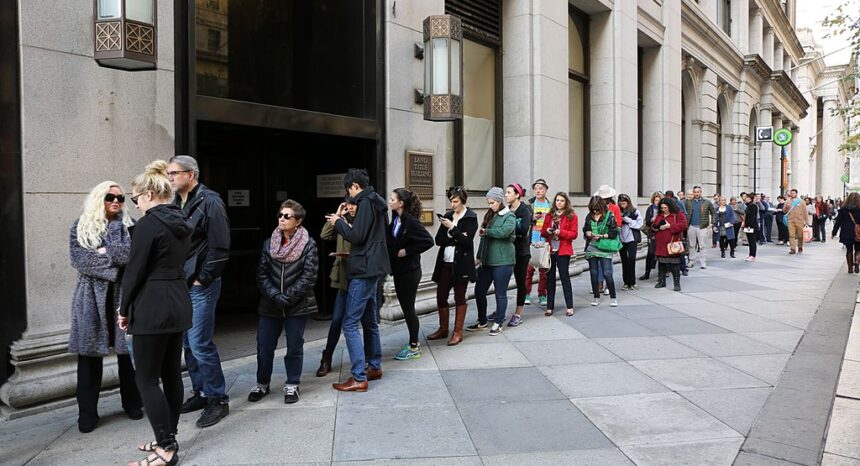When a state requires voters to show photo identification, it takes longer to vote at polls that primarily serve minority neighborhoods in that state, suggests a new study of polling place dynamics during the 2016 presidential election.
The opposite is true for precincts serving predominantly white neighborhoods. In November 2016, it took less time to check in and receive a ballot at these polling locations in states that required a photo ID, compared with states that did not, find the authors of the study, “Waiting to Vote in the 2016 Presidential Election: Evidence from a Multi-County Study.”
The authors explain that electronic equipment that reads driver’s licenses helped speed up the voting process in states that require a photo ID — at polls where the majority of voters were white and, therefore, more likely to have an ID. When voters lacked the required ID — prior research indicates a greater share of black and Latino voters don’t have it — they slowed down the process.
“In majority-white polling places, the effect of requiring a photo ID to vote reduces check-in time on average by forty seconds,” the authors write. “In majority nonwhite polling places, where we expect a lower percentage of voters to have a valid photographic ID, a photo ID requirement significantly lengthens the time to check in by thirty-two seconds.”
To conduct the study, more than two dozen research teams spread out across the United States on Nov. 8, 2016, to observe and time voters as they waited in lines, checked in to vote and completed their ballots. Researchers visited 19 states, collecting data from a combined 605 polling places in urban, rural and suburban areas.
While it’s not possible to generalize the findings to the entire country, they offer new insights into what influences voter behavior at polling places. Lead author Robert M. Stein, a professor of political science at Rice University, says what voters experience at the polls can affect their ballot selections as well as the likelihood they will participate in future elections.
“It is a consumer experience and it’s consequential,” Stein explains. “Just like going to a grocery store or restaurant, good service breeds repeated use. Voters have a finite time to vote. If they lost time getting there [to the polls], there’s less time for voting. Longer lines may mean they don’t complete the ballot.”
The study, forthcoming in the journal Political Research Quarterly, also finds that:
- Although some voters became discouraged by long wait times, voters were especially likely to stick around when lines were quite long — exceeding 100 people. “It is only in the very longest lines where voters appear particularly likely to tough it out,” the authors write. Stein says voters who have waited in line an hour or longer are unlikely to leave because of the time they already have invested.
- Lines to vote were longest in the morning. “The average morning queue is nearly three to five times greater than midday or evening,” the authors write.
- In the evening, people spent less time in line but took longer to fill out their ballots. They spent an average of 246.5 seconds to complete their ballots in the evening compared with 212.7 seconds in the morning and 218.3 seconds in the afternoon. The authors indicate that voters might have had more time in the evening to consider their choices. The researchers suspect “that voters who ballot in the midday and evening take advantage of the shorter time to check in by taking longer to cast their ballot,” they write.
Stein says that improving voters’ experience at the polls will encourage them to stay in line, fill out their ballot and continue to participate in elections. He suggests journalists who cover elections pay attention to the physical characteristics of polling places.
If there’s not enough parking, people will leave without voting, he says. Without adequate lighting, some people might feel unsafe voting early in the morning or late in the evening, when it might be most convenient for them.
Voters might avoid polling places located in isolated areas, far from main thoroughfares. It might also be tough to recruit poll workers for those precincts.
Having enough poll workers is crucial, says Stein. He and his colleagues assert that adding more poll workers can cut wait times and reduce the number of people who leave the line without voting.
For each added poll worker, the line shortens by four people per hour, on average, according to the study.
The authors note two findings they say they did not anticipate. They discovered that electronic voting machines did not have a statistically significant effect on the time it took to cast ballots. That contradicts earlier research that suggests voting with machines takes longer because voters are unsure how to use them. Stein and his colleagues note that voters might simply have become more familiar with voting machines over time.
The researchers also learned that the time voters take to complete their ballots is unaffected by the number of choices they have to make in terms of electoral races and ballot questions
“We suspect voters are either prepared to navigate a long ballot or simply undervote, in both instances, netting no effect on the time to cast a ballot,” they write, adding that straight-ticket voting might also help voters in counties with long ballots reduce their voting times.
If you’re looking for more election-related research, check out our write-ups on the consequences of “horse race” journalism, the link between newspaper closures and split-ticket voting and how high home foreclosure rates impacted Latino voter turnout in 2016.


Expert Commentary